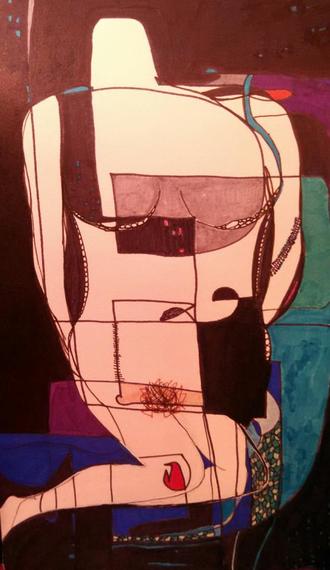"The Fairly Quiet Hour" by E.L. DeLeo was the 2013 winner of the Suzanne Tito Prize in Creative Nonfiction, selected by guest judge Natalie Singer. Part of the prize was publication of the memoir in Alligator Juniper, Prescott College's national literary magazine. But the distinction for DeLeo's memoir doesn't stop there; more recently, "The Fairly Quiet Hour" was selected for inclusion in plain china, Bennington College's journal showcasing the best undergraduate writing in the country.
A little back story: The first time I saw DeLeo she was observing me observing my students where they were leading a writing workshop at Good Samaritan Village, an elderly living facility in Prescott, Arizona. The students were in my Writers in the Community class, a practicum that pairs advanced creative writing students to lead workshops for under-served populations all over town: homeless, HIV-positive support groups, addicts, disabled, veterans of war and the elderly among them. Deleo was in a different practicum--Newspaper Journalism--the class that produced the college's newspaper. So she was on assignment, to observe Writers in the Community in action, and do a story for The Raven Review.
I mention all this by way of introduction, but also because in retrospect, it is so fitting that my first meeting with the future author of "The Fairly Quiet Hour" would be about observation. If there's one thing you notice immediately about her, it's her eyes; big and brown, they miss nothing. I don't know if I've worked with a student more able to sit, to quietly observe the world around her, and then render that world in gorgeous, unique and specific detail. These skills and others make her a fine writer. But on this day that we met, I didn't know that yet. That was spring.
The following semester, fall, Erika was in both of my classes--this meant we saw each other every day. On Monday/Wednesday, she was one of twelve students in Memoir; on Tuesday/Thursday, one of ten in Literary Journal Practicum, the course that acts as staff of Alligator Juniper. On Fridays I held office hours all afternoon and Erika was frequently planted in my easy chair. Through this daily contact, we bonded. Hours upon hours in the Alligator Juniper office, reading thousands of pages of submitted fiction, we sometimes became delirious. Concurrently, in Memoir class, Erika was drafting an exquisite, important memoir about having spent most of her teenage years in a series of psychiatric hospitals. Given the length and breadth of her experience with these residential treatment centers, DeLeo managed to write a memoir that was both beautifully spare (I dare you to find one extraneous detail) and finely focused (organized around one particular hour in which time was suspended). We workshopped it in class, where it was very well-received, and a couple weeks later, she submitted it to the student contest. The next February, when winners were announced, it was no surprise to me that she won. She got some cash. She got it published. "The Fairly Quiet Hour." Find the prize-winning memoir here and here.
An excerpt from the judge note by Natalie Singer:
"...surreal-feeling tale of the author's commitment to a psychiatric ward at the age of 16, after a suicide attempt."
Another:
"...the style evokes exactly the sense of clinical detachment married with life-threatening menace with which one imagines a psychiatric hospital would infuse its guests."
DeLeo gives us this stark introduction to her experience in this New York hospital. (Note: the name of the hospital in the memoir is fictional.)
"There is a liquid line between those who are called sane and those who are not."
"The lake is not viewable from any window inside, nor even from our 'backyard' to which we are taken each day during the warmer months for 'picnics' and 'cookouts.' Our fresh air is contained by a twenty-foot-high chain-link fence. Carefully mowed lawns, which few patients ever step foot on, surround the overlapping compound of tungsten blocks and passageways."
The containment of the fresh air, the forbidden quality to the outside world, adds to the narrator's alienation.
This next excerpt comes from a meeting where patients may express concerns about community issues:
"I bring up the fact that the only channel ever on in the common room is BET, which plays primarily hip-hop and R&B music videos. The eardrum-grinding pulses permeate every sonic inch of the unit, preventing me from concentrating on anything useful I might do with my free time.
My comment is immediately rebuffed by the other girls. They claim I ...am the only one who dislikes BET. This is not exactly true. A tiny, enormously-spectacled girl named Stephanie...who leaves each day on a highly exceptional exception to attend A Midsummer Night's Dream rehearsals at her high school, does not like BET either.
I offer MTV as a possible compromise. They play hip-hop on MTV, I point out. The staff mediator, Ms. Brien, explains that five years ago, a girl on our unit watched Linkin Park's "In the End" video on MTV and later reported suicidal thoughts, so the channel was banned.
'That was five years ago,' I say. 'She isn't even here still.'
Ms. Brien sighs. 'Guess what. This ain't the Holiday Inn.'"
Particularly endearing is the narrator's use of free time to study for her SATs. DeLeo's incorporation of the SAT prep accomplishes multiple purposes. Not only do we see this very smart girl, preparing for her life after this place, for a brighter future, but the specific vocabulary words and analogies in the exercises she undertakes, resonate with the themes and undercurrents of this memoir. This is DeLeo being efficient, giving her sentences and scenes more than one function.
Similarly efficient and evocative is this scene:
"A one-by-two-foot west-facing window sits over the head of my bed. Each day during Quiet Hour, a slab of light slips through it and creeps onto my blanket. This is the signal for my ritual. I place my journal inside the slab so the words gleam on the page. Sunlit words make me feel optimistic. As the sun arcs downward, the slab slides toward the foot of my bed. I inch my journal along with it so it stays inside of the sun while I write. In order not to block the path of light, I have to kneel on the floor, but I do not mind because this makes it even more of a ritual."
Readers see the narrator here as supplicant before the forces of her own sadness, ameliorated by light. All of DeLeo's material is as gracefully handled.
Despite the gravity of the situations in which the narrator finds herself, DeLeo manages to incorporate humor into the memoir, via the narrator's perception of the hospital and its characters.
"When someone is considered out of control or unsafe, a team somewhat like mall security is called to regain control of the person. These bulky, rote men occupy a part of the building unknown to us, and can arrive onsite within seconds."
Mall security! That's funny.
In a successful memoir, we should not only get to know our narrator better but we should be informed about something, let into a world we might not otherwise access, learn something new. Having worked briefly as an aide in a psychiatric facility myself, the world inside those walls wasn't foreign to me, but one thing that had not occurred to me was the fact of these teenagers' siblings. We rarely think of this--the confused younger siblings at home. In DeLeo's case, the eight-year-old sister who thinks Erika is on "a private vacation," and the five-year-old brother who pores over family photo albums, searching for images of the sister he misses. The sadness of the depressed adolescent seeps into the lives of her siblings.
In this next passage, the narrator has just been held down and given a shot of Thorazine. In this quote, DeLeo skillfully isolates the moment the tranquilizer takes effect:
"They shut off the light as they leave the room. I remain on my side for several minutes, taking shallow breaths. They will not control me, I think. I rise and walk into the common room where a staff member sits on the couch, watching the news on mute. I walk toward a couch on the other side of the room. Before I get there, a rush of heat seeps into the back of my skull; I see black, and then I am kneeling on the floor."
As DeLeo builds to her memoir's climax, the narrator has her own frightening encounter with "Mall Security."
"Then the hand squeezes my shoulder, but not in a forgiving way. It squeezes as if to lift me by my shoulder.... I forgot why men open jars."
This comment about men and jars may be the most novel description of brute strength I've ever read.
As the narrator is thrown onto the bed where she will be restrained, DeLeo writes:
"I hit the bed like a car accident: that moment when you become acutely aware of your velocity in the world, and how startling it is to be stopped."
The most redemptive moment of this memoir occurs near the end, when an aide on the ward, a Haitian woman, holds the young Erika on her lap.
"For many nights after the restraint, I wake up kicking, mashing, scraping, knees, ankles, toes against cinder block. While in half-sleeps, uncontrollable whimpers and shouts come out of me. On one of these nights, a grandmotherly staff member named Mrs. Rousseau is working. She calls me out into the common room, puts down her knitting and says, 'Sit on my lap, young dear.' She is no bigger than I, but I do. She puts her arms around me, rocks me back and forth, and coos indistinct comforts in my ear for a very long time. I close my eyes and pretend I am in Haiti where she is from. I am wrapped in a blanket on the beach. I am not a mental patient. I am sane. I am free."
The Haitian woman's move is the most instinctive/informed gesture any mental health worker has exhibited in this memoir. We get that she's probably breaking rules by doing what she does, but her maternal instincts are precisely what's called for.
So here's a sad fact: the hour in restraints works. It brings about the desired effect. Not because the source of the narrator's pain has been ferretted out and confronted and dissolved or managed, but because the threat of being put in restraints again is ever-present. The method breaks the behavior as though it were a wild horse. The narrator, after an hour stretched out and strapped down, conforms to the desired behavior. Submits. Is tamed. What choice does she have really?
But this is where it gets good:
While the reality of that fairly quiet hour in restraints is horrific for the narrator (read it), what DeLeo has done with it, in a literary sense, is transform it to something beautiful and poignant. Viewed through a literary lens, the scene where she is rocked by the Haitian woman and the scene in restraints, offer up together unimaginably lovely contrast. In one we have the stretching out of the body on a flat surface, the strapping of wrists and ankles too tightly to a wooden frame. In the other scene, we have the folding up of that same body, the fawn that is this girl, into the warm and loving arms of the Haitian aide. She rocks her like you would a baby. Yes, yes, we readers cluck to ourselves. Finally, some love.
So in the grappling with this, DeLeo makes these literary choices that transform horror into beauty. By making this contrast so potent for the reader, DeLeo leaves us thinking more about how stunning her writing is, rather than how awful the hour was. This is the power of memoir, for both the writer and the reader. DeLeo owns and shapes and crafts her disturbing experience. Readers get the benefit of a product enhanced by passage of time, and insight, and the writer's gift for narrative.
Similarly empowering, the memoir's ending serves up potency and beauty and hope. Six years have passed and DeLeo is a student at Prescott College in Arizona. To stave off impending depression one day, the narrator hurriedly packs a bag and gets in her car and drives "seven music-blaring hours" to a California beach. She just as hurriedly rents a surfboard and a wetsuit from a roadside shop, and "yanks" the wetsuit on before running into the ocean. There's an urgency to this quest. She's never surfed and is batted about by the waves. After a half hour of this, she drags out of the water and a guy who's been watching her says, "Would you like some help?" This question strikes the reader as being as brilliantly simple and as simply brilliant as the Haitian woman's embrace. Would you like some help? I mean, yeah.
The narrator answers, "Yes, I really would." And in no time, with a little instruction and a little shove, she's standing, sailing, surfing a wave. This final human exchange, this would you like help? Yes I really would, reverberates through all we've read so far. 
Prescott College gets its share of students who struggle, as I'm sure every college does. Because many of our courses take place in the field, during month-long intensives, professors are necessarily provided with medical records on students we will travel with for the month. I recall one intensive where three students on my roster of twelve were either currently on medication for psychiatric disorders, or had psychiatric histories. Courses like The Memoir naturally draw students who have life material they wish to better understand. By grappling with that material, in a controlled academic environment, students get to transform the experience into a piece of writing, elevate it to the level of art. While I make it very clear in my syllabus and on the first day of class, that this class is not group therapy and I am not a therapist, students comment at course end that the experience has, nevertheless, been therapeutic. It's just a by-product of grappling intellectually and artfully with puzzling aspects of our lives. Students report leaving the course feeling lighter, less burdened, and always, in awe of their classmates' lives and bravery and talent. 
Shortly after DeLeo's memoir appeared in the 2013 issue of Alligator Juniper, she graduated from Prescott College with her B.A. in Journalism. The ceremony is a unique one, where students are first presented by a faculty member, who speaks briefly about them, and then the student has exactly one minute to speak about her/his time at the college. The woman of the Fairly Quiet Hour? This is what she did with her Fairly Potent Minute.
Now you tell me, does that look like a woman who's lost or a woman who's found? I see a Ted Talk in her future.

This little liberal arts college in north central Arizona changes lives and saves lives. While studying at Prescott College, this young woman found acceptance, found balance, found passion and found herself. At a time when people are questioning the value of a college education, stories like Erika's need to be shared.
I consider teaching to be a privilege, and consider myself lucky to have loved my job. Shepherding talents like DeLeo's, witnessing her insight, hard work, growth and self-rescue, there is no greater satisfaction for a teacher than this. Thank you Prescott College. Thank you Erika DeLeo. Thank you, Alligator Juniper and plain china. Yes, the links to the memoir again. I urge you to read it, share it, comment.
E.L. DeLeo is a writer working in New York City. You can find her on Twitter @erikadeleo.
All art in this post is generously provided by Laura Didyk.
© 2014 all rights reserved Laura Didyk. Images may not be reproduced without permission from the artist. 
Laura Didyk is a writer, editor, and visual artist living in Great Barrington, Massachusetts. Lauradidyk@gmail.com You can follow her on Instagram: @LauraDidyk.





